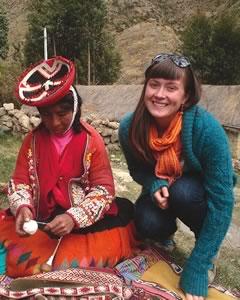Handcrafting a life in the Sacred Valley

What do you do after graduation if you’ve majored in English and Spanish, but you don’t want to teach or write?
Kaitlyn Bohlin ’07 didn’t know either. So she got on the web and searched idealist.org, a site that serves as a kind of Craigslist of nonprofit opportunities. Before long, she had an answer to her question: Awamaki.
A nonprofit organization in Ollantaytambo, a small town in Peru’s Sacred Valley of the Incas, Awamaki is, at heart, a women’s weaving cooperative.
“As a knitter and quilter, I was really excited about working for a nonprofit largely based in fiber arts and women’s rights,” Bohlin said, “and I would get to speak Spanish.”
She planned to arrive in Peru in the fall of 2008. But another fall changed that plan.
While working that summer in Zion National Park, Bohlin, an experienced rock climber, fell 100 feet. Her rehabilitation—physical, emotional and economic—took two years.
“It was a dark time,” she said. “But I gained both professional skills, through a job that I took during my recovery, and spiritual resources that have made my time in Peru much richer.”
Since August 2010, Bohlin has worked for Awamaki, now as its programs director, helping the dozens of people who come to volunteer for the organization—not only in the weaving cooperative, but in its health and education services, too—have a satisfying experience. More recently she has also become Awamaki’s tours coordinator.
“I love to travel,” she said, “and I’ve seen enough tourism at its worst that I want to contribute to positive, sustainable tourism.
For travelers who want an experience of the culture and people who live in the shadow of Machu Picchu that’s deeper than what typical travel agency tours provide, Bohlin arranges visits to Quechuan villages in the highlands, workshops with traditional artisans, even homestays with indigenous families.
In October she’ll help coordinate Awamaki’s second annual weaving retreat. Over 14 days, fiber enthusiasts will be immersed in the traditional culture of the Sacred Valley. Besides trips to Inca ruins and museums, retreat goers will meet and learn from Quechuan women their ancestral art: spinning with the Andean drop spindle, weaving on a backstrap loom intricate patterns particular to each village, and dyeing with natural pigments. Those who want more interaction can stay with a weaver and her family. There’s also a trip with a well-known textile artist to find the vibrant colors of Andean textiles hidden in trees and plants of the cloud forest.
“This is one of the world’s most fascinating fiber arts communities,” Bohlin said. “Retreat participants can see it up close and ask questions. Then they begin to see their own communities back home with fresh eyes.”
The weaving retreat serves the Quechuan women, too. It and Awamaki’s ongoing weaving cooperative are providing the weavers in impoverished highland villages with a more stable income—and with hope that their traditional art, once in danger of dying out, can still flourish.
Helping all this happen smoothly, satisfyingly, has thrown Bohlin into a steep learning curve—exactly what she wanted.
“I’m gaining professional skills here at a faster rate than if I had entered the job market in the States as an English and Spanish major,” she said. “The work experience has been fantastic. I love speaking Spanish. And I wake up in the morning looking at green mountains with beautiful Inca ruins. That kind of seals the deal!”






